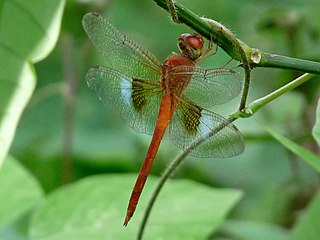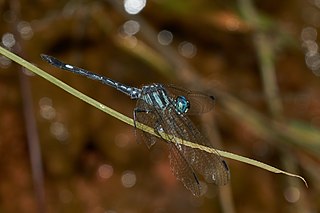
Tholymis tillarga, the coral-tailed cloudwing, is a species of dragonfly in the family Libellulidae. It is found from tropical West Africa to Asia, Australia and the Pacific Islands. Common names include old world twister, evening skimmer, crepuscular darter, foggy-winged twister and twister.

Indolestes gracilis is a species of damselfly in the family Lestidae. It is known only from Sri Lanka, South India and Cambodia.

Amphiallagma parvum, little blue or azure dartlet, is a species of damselfly in the family Coenagrionidae. This species can be found in many South Asian countries including India, Sri Lanka, Myanmar, Thailand, Nepal, and probably in Bangladesh.

Anaciaeschna martini, is a species of dragonfly in the family Aeshnidae. It is found in Japan, India, Sri Lanka, and recently from Nepal.

Anax indicus is a species of dragonfly in the family Aeshnidae. It is found in India, Nepal, Pakistan, Sri Lanka, and Thailand.

Gynacantha dravida, also known as Indian duskhawker or brown darner, is a species of dragonfly in the family Aeshnidae. It is found in India and Sri Lanka.

Epophthalmia vittata, the common torrent hawk, is a species of dragonfly in the family Macromiidae. It is found in India, Sri Lanka, and Indonesia. Three subspecies recognized.

Urothemis signata, the greater crimson glider, is a species of dragonfly in the family Libellulidae. It is widespread in many Asian countries. A number of subspecies are recognized for this species.

Zygonyx iris, the emerald cascader or iridescent stream glider, is a species of dragonfly in the family Libellulidae. It is widespread in many Asian countries.

Gynacantha bayadera, parakeet darner or small duskhawker, is a species of dragonfly in the family Aeshnidae. It is found from India to South China and northern New Guinea. This is a crepuscular species which probably breeds in forested swamps and marshy areas, or in forest pools.

Macromidia donaldi is a species of dragonfly in the family Synthemistidae. It is known only from the Western Ghats of India and from Sri Lanka.

Melligomphus acinaces is a species of dragonfly in the family Gomphidae. It is endemic to the streams of Western Ghats of India. This species was originally described as a Onychogomphus. However, both the pattern and the shape of the anal appendages do not fit Onychogomphus but are very close to those of the species placed in Melligomphus.

Lamelligomphus nilgiriensis is a species of dragonfly in the family Gomphidae. It is endemic to the hill streams of Western Ghats of India. This species has been placed by many authors in Onychogomphus but should be included in Lamelligomphus following Fraser (1934), based on the shape of the male anal appendages.

Hylaeothemis apicalis, the blue hawklet, is a species of dragonfly in the family Libellulidae, endemic to India.

Ceriagrion olivaceum is a species of damselfly in the family Coenagrionidae. it is commonly known as rusty marsh dart. This species can be found in south and southeast Asia.

Indosticta deccanensis, the saffron reedtail, is a damselfly species in the family Platystictidae. It is endemic to Western Ghats in India.

Protosticta mortoni, is a damselfly species in the family Platystictidae. It is endemic to Western Ghats in India.

Nychogomphus striatus is a species of dragonfly in the family Gomphidae. It is endemic to the streams of Western Ghats of India. Reports from Nepal require further studies.
Somatochlora daviesi is a species of dragonfly in the family Corduliidae. It was first described in 1977 based on specimens from Meghalaya, India, and is also known from Nepal and Bhutan. It resembles the east Asian S. dido in its small size and lack of yellow markings on most of the abdomen. Like other species in the genus, S. davisi is predominantly dark metallic brown to green. The formerly recognised Somatochlora nepalensis is now considered to be a synonym of S. daviesi.



















